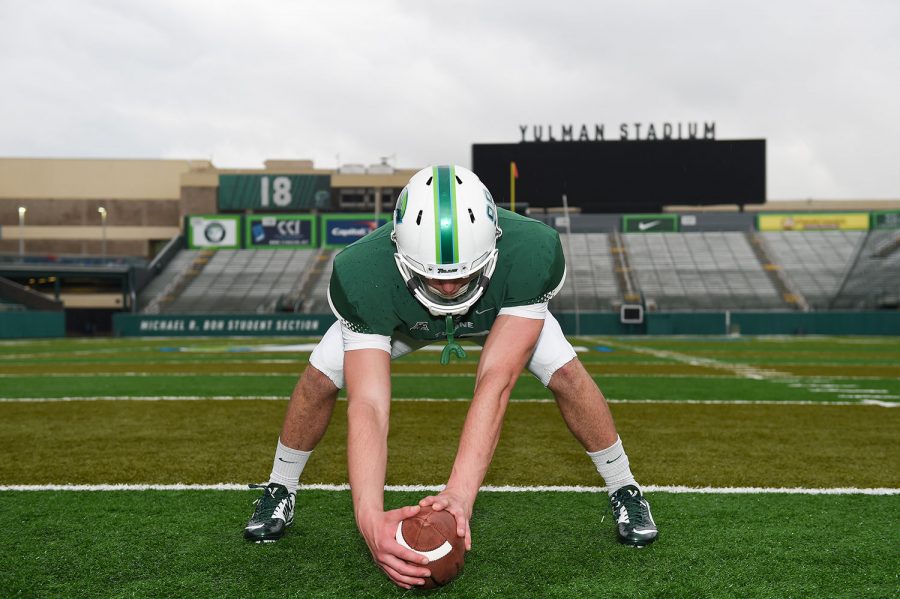Golub snaps his way into history books
Golub who has no vision in his right eye and limited in his left made history when he took the field in a 45-31 win over Central Florida on Oct. 3 as the first legally blind athlete to play for a Football Bowl Subdivision program in an NCAA game.
October 13, 2015
He digs his cleats into the weathered turf of Yulman Stadium while his fingers slide comfortably onto the leather lacing of the football. As the whistle blows, he snaps the ball, sending it perfectly spiraling to the punter 15 yards behind him. The only difference between his snaps and those of other collegiate long snappers is that Aaron Golub doesn’t get to see all of it.
Golub, a 19-year-old sophomore deep snapper from Newton, Massachusetts, was born with Peter’s Anomaly, a genetic visual impairment that has left him blind in his right eye and with weak peripheral vision in his left. Golub made history as the first legally blind athlete to play for a Football Bowl Subdivision program in an NCAA game.
In a 45-31 victory over Central Florida Oct. 3, Golub took the field in the fourth quarter with 8:20 left in the game. This successful snap helped score the extra point after the Wave’s final touchdown.
Golub doesn’t let his visual impairment get him down and has been playing sports since childhood. But it was not until recently that he became serious about football.
“In high school I really decided I wanted to try and play in college, and I figured there were not a ton of great long snappers out there so if I got good enough then maybe I would have a shot,” Golub said.
Despite having limited vision, coach Curtis Johnson treats Golub the same as every other member on his team.
“Every morning I’m up, he’s up in the weight room and he’s working and working and working,” Johnson said in an interview with NOLA.com. “I would like to play him as much as I can because that’s what you do, you reward kids who work. I don’t care what they are or how they look. This kid works and he’s just like everybody else. I’m going to play him as much as I can.”
In fact, he is not even a fan of the press because he doesn’t think of himself as any different.
“I just don’t think about it,” Golub said. “I think of myself the same as any other player and so I don’t focus on my vision as an issue. Personally, I’m not really a fan of any of the whole media stuff but the only reason that I’ve done any of it to begin with is because in high school my long snapping coach, who I went to [recruiting] camps with, told me, ‘I know you aren’t a fan of this but if you can help even just one person and make them do something because of it then it’s worth doing.’ So that’s the whole reason I agree to all the interviews.”
Golub works hard for himself, not for the accolades and attention. His appearance in the game made history and broke barriers. He is even a snowboard instructor in New Hampshire, proving yet again his disability doesn’t have to deter him from what he wants.
It may be hard to get a glimpse into the life of Golub, but he’s comfortable showing others the way he sees the world.
“I have a pair [of goggles] that I bring to the camps [for kids] that I go to because the coaches love for me to bring them out and show people,” Golub said. “And then I’ve showed almost all of the coaches here and anybody else who’s curious to see them, to simulate my vision.”
Most NCAA collegiate sports teams have not honored a student with a physical disability like Golub’s. Most disabilities within the sports programs are classified under mental health. Since 2008, the NCAA has seen a steady increase in disorders such as depression, anxiety, adjustment issues, as well as panic and PTSD. A disability is classified as “a current impairment that has a substantial educational impact on a student’s academic performance and requires accommodation,” according to the handbook.
There is a waiver that players can fill out if they have a disability, but it is not required; as a result, many disabilities go unnoticed and undocumented. Golub’s impairment is not something that can be easily hidden, but that never deters him from putting his best effort forward.
“[After the huddle] I just run out on the field and get set over the ball and get ready,” Golub said. “I make sure everything is right, my feet and my hands, and get the right hand placement on the ball [and] then just focus. Next I look back for the spot that I want to put it on, snap it and trust my form.”























Leave a Comment